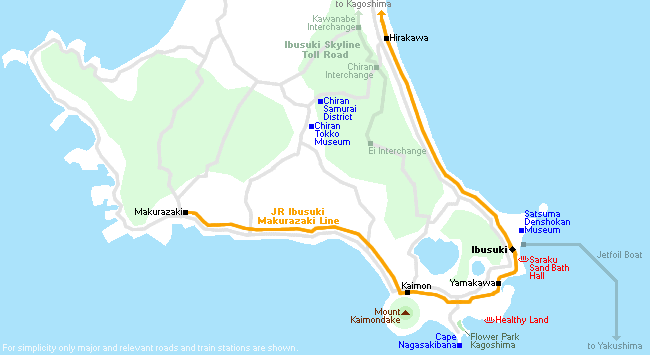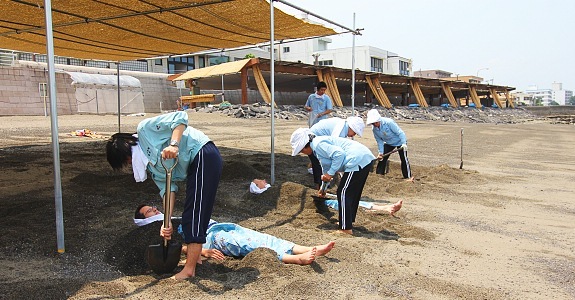(和文は英文の下)
On Saturday, I went on the LONGEST day trip EVER traveling to and from the most inaccessible place in Aomori Prefecture, Sai Village in Shimokita Peninsula.
Shimokita Peninsula(下北半島 - Shimokita hantou) is the Northeast region of Aomori Prefecture. It is often called "the hatchet" because of its distinctive shape. It is arguably one of the most rural places left in mainland Japan because of its inconvenient location and mountainous terrain. While it is most famous for a sulfuric volcanic landscape called Osorezan (恐山- "Fearful Mountain") and the big tuna fishing town called Ooma (大間), we did not visit those locations that day. For the story on those places, see
here.
This time, we went even deeper into the wilderness of Shimokita to a place called Sai Village(佐井村 -
Sai mura). It is located along the blade of "the hatchet" and can only be accessed through steep mountain roads or by small ferry boat.
First, we arrived in Kanita (蟹田 - "Crab Field") on the Eastern coast of Tsugaru Peninsula. The organizers had planned to take the
Mutsuwan Ferry from Kanita to Wakinosawa (脇ノ沢 - "Pit Swamp") at the southern tip of the hatchet blade to avoid driving around the entirety of Mutsu Bay. Sadly, it was much more expensive than driving and only saved us about an hour on the road.
While we waited for the ferry to depart, we climbed the tall "Topmast" observation tower and got a great panoramic view of the bay and the surrounding coastline. The observation deck's floor is made of steel grates, so you can see all the way down to the bottom. Some of the other travelers were afraid of heights, so they tiptoed around on the concrete borders surrounding the metal grates.
 |
| The Topmast |
 |
| Don't fail me now, steel grates. |
 |
| The view from the top. |
After we arrived in Wakinosawa, I was surprised that we still couldn't drive directly to Sai Village. The road that runs along the blade of the hatchet is treacherously steep and narrow, so the bus driver didn't want to risk passing through. Instead, we look a long detour through the mountains, arriving in Sai Village at around noon. Everyone was tired and hungry, and our day had yet to even begin. We had a small lunch at a restaurant in the tourism building, called ALSAS. I found the welcome sign particularly interesting.
 |
| Nothin' like a dead bear greeting you at the door. |
After lunch, we got a tour of the village. Since we were low on time, they took us to the 3 largest landmarks. The first was the preserved house of a famous local doctor, Mikami Gotaro (三上剛太郎先生). He had served as a medic in the Russo-Japanese War and was famous for saving the lives of more than 70 people in a particular incident. Surrounded by Russian troops, Mikami patched together a red cross flag using bandages and pieces of a red blanket. Upon seeing the flag, the Russian troops didn't attack, and Mikami was able to treat the wounded of both the Japanese and Russian sides.


Next, we went to visit the Hachimangu Shrine (八幡宮)at the top of a hill. The shrine itself is more than 300 years old, but the site it was built on has an even longer history. Strewn around the shrine grounds are many arrowheads that date all the way back to the Jomon period (14,000 - 300 BC!) and were used by the first human civilization to inhabit the islands of Japan. This history give the shrine its nickname, Yanonemori (箭根森 - "Forest of Arrows")
Finally, we paid a visit to an old Buddhist temple. Inside, there were relics from all around Japan and Europe, which were collected by the wealthy owner of the shrine. Apparently, the temple had burned down once before, but the owner was so wealthy that he paid for its reconstruction entirely out of his own pocket.
As the tour came to an end, we found out why they didn't feed us very much for lunch. We were going to board a small boat, the
"Sai-light"(サイライト), and take a ride to
Hotokegaura(仏ヶ浦). This day was particularly windy, and the waves were choppy. As I stepped into the boat, I immediately regretted it.
 |
| Behold, the sketchiest boat to ever sail the Bay of Aomori. |
The captain told us that the ride would be similar to a roller coaster, but I didn't believe him until we left the harbor. We were getting battered from all sides by big waves, and we managed to fly into the air several times before crashing back down. The ride was so turbulent that the video being played on the boat's television screens would periodically pause and skip. We hit a particularly big wave, causing the girl next to me to empty her entire can of iced coffee into the air, which then rained back down all over me. It was fun and games at first, but the comedy wore off when we realized the ride would last another half hour.
Halfway through, I looked to my right to see a girl emptying her stomach into a clear plastic bag, filling it to the brim. I looked behind her, and my girlfriend was also keeled over trying to keep her lunch in. The passengers on her side were passing plastic bags back and forth in an attempted containment. I suddenly felt thankful that I only had to deal with splashing coffee. I was also amazed at how my stomach was handling such a violent ride so well.
After an excruciatingly longest 30 minutes, we finally docked at Hotokegaura and disembarked. My girlfriend sat down and stared blankly at the shore. I ushered her forward because we only had half an hour to explore the incredible coastline.
 |
| Kristin pretending to be fine |
And what a coastline it was! The erosion of the limestone along Hotokegaura left tall white spires in all kinds of interesting shapes. I walked around and snapped photos as the guide described what each spire looked like and compared it to some sort of animal or person. Many people believe that these spires represent gods that look out at the sea and protect sailors from harm.
As our 30 minutes came to an end, the passengers gathered around the boat and grudgingly stepped aboard again. While the ride back was not quite as bad as before, it was still enough to make Kristin double over with nausea once more. After returning to Sai Village, we had a short chat with the owner of the ferry service. He told us that the ocean is usually very calm and the ride is very comfortable. That day was just the worst day to be riding on the boat. Some friends that visited on a different day confirmed that the ride is smooth.
With the rough day behind us, we departed towards Aomori City. We didn't take the ferry route back, instead decided to drive through the handle of the hatchet to return home. As expected, it was a long 3-hour journey, but we got to stop at one of our favorite handmade tofu shops called
Yuusuitei (湧水亭)along the way to grab some tofu donuts, soy yogurt, soy milk, and gourmet black-bean natto.
 |
| Mmm, my favorite natto ever! |
All in all, it was a VERY long trip, but also very satisfying. Thanks for reading, and don't miss the next trip!
土曜日に一番長い国際交流会観光の旅をした。朝8時から夜8時までずっと青森の一番険しい「下北半島」と言う所まで日帰りをしてました。
下北半島は青森県の東北にあります。形は斧と同じなので、外国人に「ザーハチェット」と呼ばれています。本州に最後残ってい
る正真正銘の「田舎」の所かもしれない。下北半島の有名な所は地獄みたいな恐山とマグロの大間町なんだけど、その日は行きませんでした。前の旅行の詳しく
は
こちら。(英語のみ)
今回、もう少し自然に落ち込んで「佐井村」まで行きました。ハチェットの刃先にあるところで、行く方法は山道運転か小さいフェリーです。
まず、津軽半島にある「蟹田」に着きました。むつ湾を回らなくてまっすぐむつ湾フェリーでまっすぐ刃先にある「脇野沢」に行くことにしました。残念ながらフェリーが運転より一時間だけ早くて、ガス代よりずっと高い方法です。
フェリー出発を待っていた間、「TOPMAST」と言う展望台に登って青森湾のきれいな景色を見ました。足の下は全部スチール網なので、かなりドキドキな経験でした。
高所恐怖症がある参加者が網の周りのコンクリート部分だけに歩いていた。
フェリーに乗って脇野沢に着き、まだまっすぐ佐井村までいけないと聞いたらびっくりしました。刃先に海のそばの道路はとても狭くて険しくてバスで通るのは
危険だそうです。代わりに、山道に通って昼に佐井村に着きました。皆さんはもう疲れてきて、おなかも空いてきました。佐井村役場津軽海峡文化間「アルサ
ス」の中のレストランで昼食をいただきました。挨拶のサインは特に面白かった。
昼食後、佐井村の歴史案内されました。あまり時間なかったので有名な3つの所だけつれてくれました。まず、有名な医師、三上剛太郎、の家を見ました。日露戦争に70人以上の命が三上先生のおかげで救われたと聞きました。赤十字の仕事もいっぱいできた見たいです。
次、八幡宮「はちまんぐう」神社に行きました。神社のほうは300年以上の歴史がありますが、その土地がもっと長い歴史があります。縄文時代の矢の根が散り敷いていて、ガイドさんが一個探して見せました。昔、近所の子供達がこの矢の根を狩りましたが、今はこんな歴史がある土地を守らないとだめって教えてくれました。
ツアーの最後にお寺を見に行きました。前、火事があってお寺が全滅でしたが、大金持ちの一人だけのお金で立て直しました。中身にいっぱい日本と海外の宝物があるそうです。
町案内終わってから、船を乗る時間になりました。船の名は「サイライト」で、小さい船でした。その日は特に風が強くて波も高かった。船の中に入るとすぐ後悔しました。
ジェットコースターに用に揺れると船長さんに教えられたが、港を出た前には信じなかった。船があっちこっち激しく揺れて、空に飛び出すこともあった。テレ
ビに映していたビデオも時々止まっていた。特に高いジャンプのとき、隣の人の缶コーヒーの中身が飛び出して、茶色い雨が振り掛けられました。最初はこんな
クレイジーな経験がありえなくて、あほみたいに大笑いしていたけど、現実に戻ったら後30分乗らなくてはいけないと気づいた。
15分後、右側に向くとある女性がプラスチック袋におなかの中身を出していた。「袋いっぱいだな。すげ~」と思っていた。その子の後ろに彼女のクリスティ
ンが吐かないようにくの字に曲げていた。そこらへんの乗客がプラスチック袋をたくさん別ち与えた。自分は「コーヒー雨の問題だけでよかった」
とありがたく感じました。自分のおなかが意外と平気で、びっくりしました。
歴史に一番長い30分が終わってから、やっと仏ヶ浦に着いて船に降りました。クリスティンがドックに座ってぼうっとしました。30分観光時間しかなかったので彼女を引っ張って進みました。
でも、仏ヶ浦ってなんときれいな所です!高くて白い岩があって、色々な形ありました。ガイドさんが岩の形の名前を説明してくれました。その岩が海を見守っている神様だと教えました。
30分が終わってまた船に乗り時間になりました。いやな顔で船に入って、もう一度トラウマの経験でした。帰り道のほうが静かだったけどまだ激しかった。そしてクリスティンの吐き気も戻りました。佐井村に着き、船の会社の社長とお話しました。普通は津軽海峡はとても静かなんですけど、その日は最低な状況でした。やっぱり運が悪かったね。
話が終わり、帰る時間になりました。フェリーに乗らずにずっとバスで帰りました。3時間以上かかりましたが、途中で横浜町にある大好きな豆腐屋さん「湧水亭」に止まって豆腐ドーナツ、ヨーグルト、豆乳、そして黒豆納豆を手に入れた!とても長い旅でしたが、やってよかった!

































